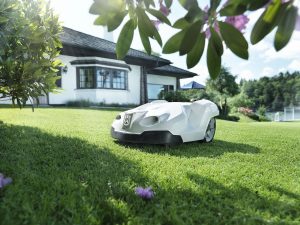Robotic mowers have gained popularity for their ability to keep lawns looking immaculate with minimal effort. However, like any piece of technology, they come with their share of drawbacks. Understanding these disadvantages will help you make an informed decision before investing in one.
While robotic mowers can save time, some limitations could outweigh the benefits depending on your needs. Issues such as cost, maintenance, and performance in certain conditions should be considered.
In this guide, each disadvantage is clearly explained to help you understand the potential downsides. By the end, you’ll know whether a robotic mower is right for your lawn care routine.
What Are The Disadvantages Of A Robotic Mower? Top 10
1. High Initial Cost – Why Robotic Mowers Can Be Expensive
The price of a robotic mower is one of its most notable drawbacks. Compared to traditional mowers, they can cost two to three times more upfront. This makes them less accessible for homeowners with limited budgets.
While the investment may save you time, it takes years to see a return in cost savings. Some models require additional accessories such as charging stations, boundary wires, or GPS units. These add-ons can further increase the total purchase price.
For some users, the long-term benefits might not justify the steep initial outlay. This is especially true if your lawn is small or requires minimal maintenance.
Pros:
• Time-saving
• Quiet operation
• Low emissions
• Consistent cut
• Low energy use
• Programmable
• Hands-free mowing
Cons:
• Expensive upfront
• Extra accessories
• Slow ROI
2. Limited Cutting Power – Struggles With Tough Grass
Robotic mowers often have less cutting power compared to gas or high-end electric mowers. They are designed for regular trimming rather than tackling overgrown lawns. This can be an issue if you skip mowing sessions.
Thicker grass varieties, weeds, or wet turf can challenge their cutting efficiency. The blades may dull faster when faced with tougher vegetation, leading to frequent maintenance. Performance issues become noticeable when the mower deals with uneven or dense areas.
If you have a lawn that grows rapidly or contains coarse grass, you might need a backup mowing solution. This reduces the convenience factor robotic mowers are known for.
Pros:
• Gentle on lawn
• Even cutting
• Energy-efficient
• Low vibration
• Less noise
• Lawn-friendly blades
• Automatic operation
Cons:
• Weak power
• Not for thick grass
• Struggles in wet
3. Small Cutting Width – More Time to Cover Lawn
Many robotic mowers have a narrow cutting width, meaning they cover less ground per pass. While this isn’t an issue for small yards, it can be a problem for larger lawns. It takes more time for the mower to finish the job.
The slow pace is due to their methodical, random navigation patterns. Even though they eventually cover the entire lawn, the process can feel inefficient. This contrasts with traditional mowers that make straight, wide passes.
If speed is a priority, a robotic mower’s slower coverage could frustrate you. This is especially true if you want quick, same-day results after long periods without mowing.
Pros:
• Precise trimming
• Uniform results
• Reduced turf damage
• Less missed spots
• Quiet mowing
• Eco-friendly
• Low running costs
Cons:
• Slow coverage
• Not for large lawns
• Inefficient patterns
4. Struggles on Complex Lawns – Limited Terrain Handling
Robotic mowers work best on simple, open lawns without too many obstacles. Complex yard layouts with flower beds, slopes, or narrow passages can confuse the mower. This can lead to missed spots or uneven mowing patterns.
They are often less effective on steep slopes or bumpy terrain. Navigation systems, while advanced, still have limits in detecting all hazards. Some units may get stuck or require manual repositioning.
If your yard has multiple zones, separate mowing sessions or manual intervention may be necessary. This reduces the hands-off convenience robotic mowers promise.
Pros:
• Low maintenance
• Custom programming
• Obstacle sensors
• No fuel needed
• Quiet cutting
• Safe operation
• Environmentally friendly
Cons:
• Poor slope handling
• Obstacle issues
• Needs manual help
5. Weather Sensitivity – Not Ideal for All Conditions
Robotic mowers generally perform best in dry, mild weather. Heavy rain, snow, or extreme heat can disrupt their function. Some models have rain sensors that pause mowing, but this can delay lawn maintenance.
Wet grass can clog the blades and reduce cutting quality. In colder climates, mowers may need to be stored indoors during winter months. This creates seasonal downtime where manual mowing may still be required.
If you live in a region with unpredictable weather, you might need to schedule mowing carefully. This can limit the convenience factor of robotic lawn care.
Pros:
• Energy saving
• Low maintenance
• Weather sensors
• Consistent results
• User-friendly
• Quiet in use
• Smart features
Cons:
• Not for wet grass
• Winter downtime
• Heat sensitivity
6. Maintenance Costs – Hidden Expenses Over Time
While robotic mowers require less daily upkeep, they still have ongoing costs. Blades need regular replacement to maintain cutting performance. Batteries degrade over time and can be expensive to replace.
Software updates, repairs, and occasional servicing add to the expense. If the mower suffers damage from hitting obstacles, repairs can be costly. Unlike manual mowers, most repairs require specialized technicians.
These hidden costs can add up, making the mower more expensive over its lifetime than initially expected. Planning for these expenses is crucial for budgeting.
Pros:
• Long lifespan
• Energy-efficient
• Minimal daily upkeep
• Consistent mowing
• No fuel costs
• Less manual labor
• Clean operation
Cons:
• Blade costs
• Battery replacement
• Costly repairs
7. Security Concerns – Risk of Theft
Because robotic mowers are often left unattended, they can be targets for theft. While many have GPS tracking and PIN code security, determined thieves can still steal them. This is especially a concern for high-end models.
Replacing a stolen mower is costly and often not covered by standard home insurance. Some owners choose to store them when not in use, but this adds extra handling. In high-crime areas, theft risk may outweigh the benefits.
Investing in secure docking stations or lawn enclosures can reduce risk. However, these measures also increase overall costs.
Pros:
• GPS tracking
• PIN protection
• Compact design
• Lightweight
• Portable
• Weather-resistant
• Stylish appearance
Cons:
• Attractive target
• Insurance limits
• Extra security costs
8. Limited Battery Life – Frequent Recharging Needed
Most robotic mowers rely on rechargeable batteries, which have finite runtime. Large lawns may require multiple charging cycles to complete a single mow. This can prolong the total mowing time.
Battery performance can also decline over the years, reducing efficiency. Replacement batteries can be costly, adding to long-term expenses. Even with efficient charging docks, the downtime may frustrate some users.
If you need quick, uninterrupted mowing, a robotic mower’s battery limitations might be a dealbreaker. This is especially true for lawns larger than the manufacturer’s recommended capacity.
Pros:
• Quiet operation
• Automatic charging
• Energy-efficient
• Low emissions
• Lightweight
• Easy to install
• User-friendly
Cons:
• Short runtime
• Costly battery
• Slow completion
9. Limited Edge Cutting – Manual Trimming Still Needed
While robotic mowers can cover most of your lawn, edges and corners often need manual trimming. Their rounded shapes and navigation patterns make it hard to reach every spot. This means you may still need a trimmer for a perfect finish.
This limitation reduces the “fully automated” appeal of robotic mowing. It also means extra tools and time are required for complete lawn care.
For some homeowners, this is a minor inconvenience. For others, it negates the main selling point of the device.
Pros:
• Consistent cutting
• Lawn-friendly design
• No emissions
• Low maintenance
• Quiet mowing
• Custom schedules
• Obstacle avoidance
Cons:
• Missed edges
• Extra trimming
• Not fully automated
10. Learning Curve – Setup and Programming Challenges
Setting up a robotic mower can be more complicated than expected. Some models require boundary wires to be installed, which takes time and precision. Programming schedules and zones may also confuse new users.
While manuals and apps guide you through the process, trial and error is often involved. Initial mistakes can lead to incomplete mowing or the mower getting stuck. Patience and technical comfort are needed to optimize performance.
For less tech-savvy homeowners, this learning curve can be discouraging. Professional installation is an option but adds to the cost.
Pros:
• Customizable settings
• Smart features
• App integration
• Future updates
• Precise control
• Automatic scheduling
• User-friendly once set
Cons:
• Setup time
• Complex programming
• Initial frustration
FAQs
1. Are robotic mowers worth the cost?
They can be worth it for those valuing convenience and consistent lawn care, but the high upfront price may not suit all budgets.
2. Can robotic mowers handle wet grass?
Most models struggle with wet grass, leading to poor cutting results and potential blade damage.
3. How secure are robotic mowers?
They have security features like GPS and PIN codes, but theft is still possible, especially in unsecured areas.
4. Do robotic mowers work on slopes?
Some can handle mild slopes, but steep or uneven terrain often causes issues.
5. How long do robotic mower batteries last?
Batteries typically last 2–5 years before needing replacement, depending on usage and care.
6. Is maintenance easy for robotic mowers?
Routine blade changes are simple, but complex repairs often require a technician.
7. Can I use a robotic mower for a large lawn?
Yes, but large lawns may require multiple charging cycles and careful scheduling.
Conclusion
Robotic mowers offer impressive convenience but come with significant disadvantages worth considering. From high costs to limited cutting abilities, these machines may not suit every homeowner’s needs.
Before investing, assess your lawn’s size, complexity, and growth patterns. Consider whether you’re willing to handle occasional manual trimming and seasonal limitations.
If the pros outweigh the cons for your lifestyle, a robotic mower can still be a worthwhile tool. But if you value power, speed, and flexibility, traditional mowers may serve you better.
Make your choice wisely, balancing budget, lawn needs, and convenience for the best long-term results.
Recent Posts
Horse bell boots designed for muddy conditions play a critical role in protecting hooves, heels, and pasterns during wet and slippery turnout. Mud exposure increases the risk of pulled shoes, heel...
Side-by-side utility vehicles with factory-installed heat and air conditioning have become essential for operators working in extreme weather conditions. These machines deliver year-round comfort...